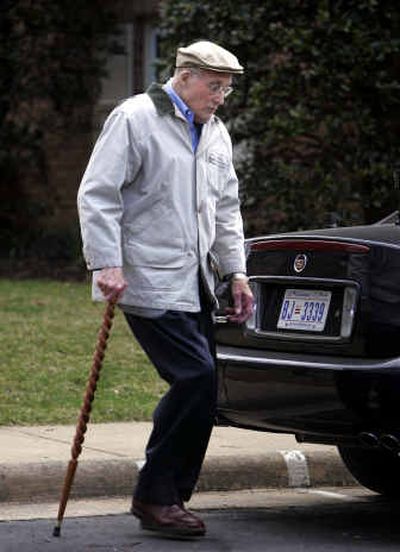Ailing Rehnquist back on high court bench

WASHINGTON – After a five-month absence, ailing Chief Justice William Rehnquist made his return to the Supreme Court bench as close to ordinary as he could. His unspoken message: It’s business as usual.
Rehnquist, who has thyroid cancer, said nothing about his illness Monday and made no note of his long absence. He convened the session promptly at 10 a.m. and extended a welcome to new members of the Supreme Court bar.
During arguments, he took his usual few minutes’ break from the bench to stretch his back. And he sternly kept lawyers on schedule.
“I see my time is up,” said Douglas R. Cole, Ohio’s state solicitor.
“It is. Thank you,” said Rehnquist, a stickler for punctuality.
Except for Rehnquist’s physical appearance – he looked frail and spoke with a slightly hoarse voice – there was nothing different about this session from the hundreds of others over which he has presided in his 19 years as chief justice.
Medical experts said it was a remarkable feat for an 80-year-old to have cancer, undergo weeks of radiation and chemotherapy and then feel well enough to return to the bench. However, since Rehnquist has not released details about his condition, they warned against reading too much into his return.
“It’s very unusual,” said Dr. Kenneth Burman, a thyroid specialist at Washington Hospital Center and professor of internal medicine at Georgetown University. “It reflects either his stamina or the tumor itself is responding” to treatment.
During the argument, Rehnquist, who had not sat for any cases since being diagnosed with thyroid cancer in October, looked frail and was slightly hoarse with a high-pitched voice.
At the conclusion, he struggled momentarily to get out of his chair. Justice John Paul Stevens, who at 84 is the court’s oldest member, helped Rehnquist to a nearby railing.
Rehnquist has not said what form of thyroid cancer he has. However, medical experts have said his treatment plan indicated he might have anaplastic thyroid cancer, which typically is fatal within a year of diagnosis. Long-term survival for such patients is only 14 percent.
It is rare for patients with that form of cancer to have any remission or shrinkage of the tumor, doctors said. More likely is that the tumor has stopped growing for now, allowing Rehnquist to build some strength.
Dr. Michael Weiss, a throat cancer specialist at the Maimonides Medical Center in New York, said without knowing details of Rehnquist’s condition it’s impossible to make an accurate prognosis. “It’s really reading tea leaves,” Weiss said.
When Rehnquist disclosed the illness, it immediately prompted speculation the court could have its first opening since 1994. But Rehnquist continued working, often from home. In recent weeks, he has been working at the court regularly and last week presided over a two-hour closed-door meeting of federal judges.
On Monday, Rehnquist left his suburban Arlington, Va., home at 8:30 a.m. Walking stiffly with the aid of a cane, he got into a limousine and was driven to the court.
When the session opened, Rehnquist emerged with his eight fellow justices from behind a curtain, as is the customary practice. He then swore in new members to the Supreme Court Bar.
No mention was made of his illness and none of the other justices said anything to him before the start of the first argument, a case from Colorado in which a woman was seeking to sue her local police department for its failure to prevent her estranged husband from killing her three daughters.
Rehnquist asked a number of questions. About midway through each of the two arguments, he disappeared behind the red curtains apparently to stretch his back, which has been his practice for some time.
Richard Garnett, a former Rehnquist clerk who teaches law at Notre Dame, said the appearance shed no light on when the chief justice might step aside.
“While his presence on the bench today was wonderful news for those of us who care about him, I don’t think it tells us anything about his retirement plans,” Garnett said.
Rehnquist was appointed to the court in 1972 by President Nixon and was elevated to chief justice by President Reagan in 1986. He is the second-oldest chief justice in history. The only older chief justice was Roger Taney, who presided over the high court in the mid-1800s until his death at 87.